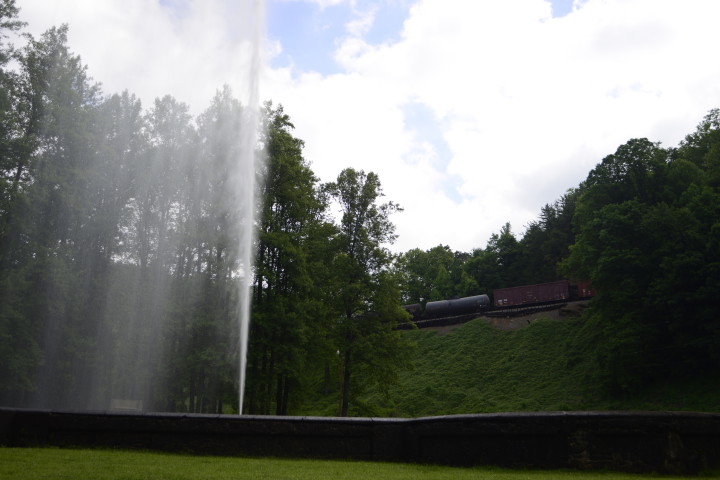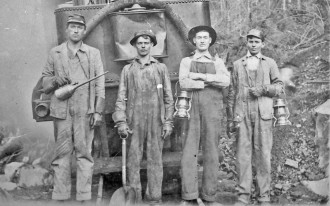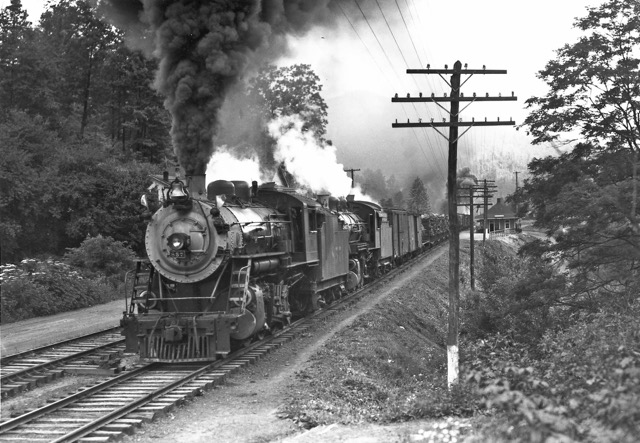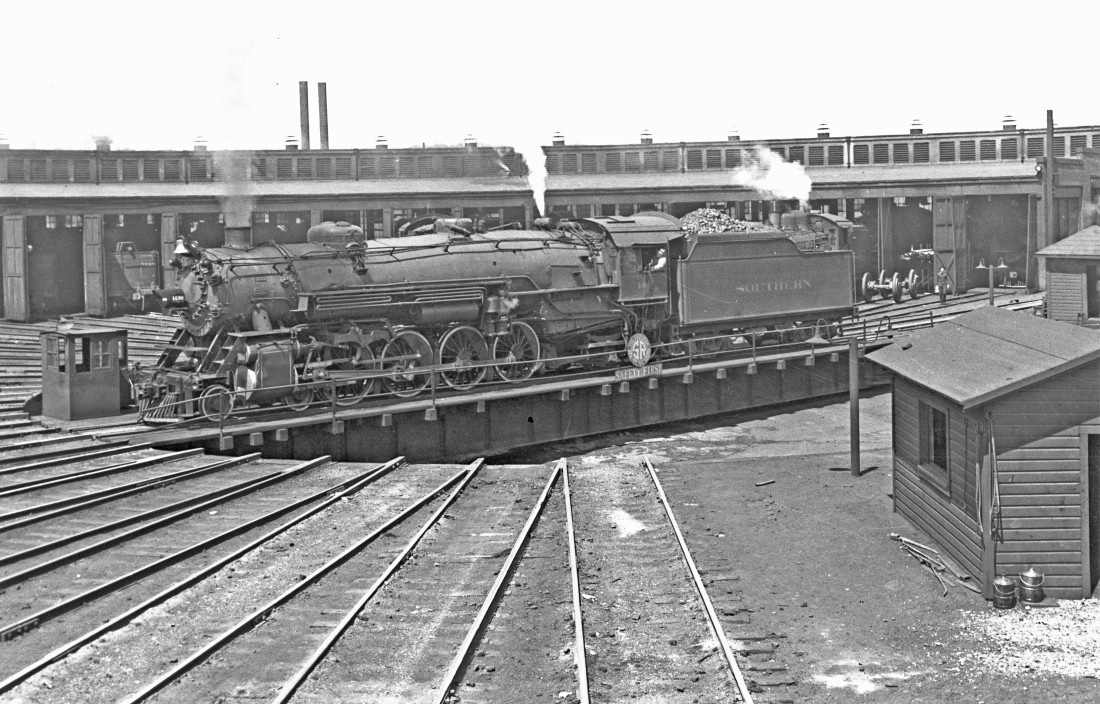A strange sight greets travelers coming up the Swannanoa Gap between Old Fort and Ridgecrest: the Andrews Geyser, which sprays a jet of water 80 feet into the air. This singular structure, built to commemorate the completion of a rail line through the gap, stands as a testament to the engineering achievements and mortal sacrifices that marked the coming of the railroad to the area.
A new exhibit at Mars Hill University’s Rural Heritage Museum, titled “How the West Was Won: Trains and the Transformation of Western North Carolina, 1880-1937,” examines this pivotal era in the region’s history.
Les Reker, the museum’s director, calls it “one of the most important installations we’ve ever featured here.” More than six months in the making, the exhibit features photographs, artifacts and multimedia culled from across WNC, reflecting the railroad’s vast influence in the region over nearly a century. The free show, which opened June 27 in Montague Hall on the Mars Hill campus, will run through Jan. 31, 2016.

Slow train coming
Plans for a rail line through the mountains extend back to the 1830s, notes Ray Rapp, the exhibit’s curator. By the 1870s, rail lines coming from the east and south had progressed to the foot of the Blue Ridge. At that point, however, travelers heading to Asheville or vacationing in Flat Rock or Warm Springs were forced to continue their journey on horseback or stagecoach.
After many setbacks, the state-owned Western North Carolina Railroad Co., headed by Maj. James H. Wilson, began boring through the mountains west of Old Fort in 1877. “Building that grade was a herculean feat,” says Rapp, a former state representative. “You’re talking roughly 9 miles of loops to go 3.1 miles as the crow flies. That’s the equivalent of eight circles in curvatures.”
Wilson brought in more than 1,800 laborers; many were convicts, mostly African-American prisoners from the eastern part of the state. The work was grueling, and many workers perished due to disease, harsh weather and several tunnel collapses. Nonetheless, on March 11, 1879, Wilson wired Gov. Zebulon B. Vance this message: “Daylight entered Buncombe County today through the Swannanoa Tunnel. Grade and centers met exactly.”
The Swannanoa Grade had cost millions of dollars and 125 lives. A year later, the first steam engine rolled into Asheville, changing life in the region forever.
Industry in the mountains exploded, as timber and mining barons whom Rapp describes as “locusts” flocked to rape the virgin forests. “They’d literally descend on the mountain and cut everything,” he notes.
Narrow gauge rail lines hauled minerals like feldspar, mica and iron to northern industrial centers and eastern ports. Temporary “light rails” penetrated the far reaches of the southern Appalachians, with tracks sometimes being laid directly over felled trees.
“We really created a colonial economy out here,” says Rapp. “The barons and mining operations didn’t really care about your land. They were gonna strip it, and once that was done, they were gone.”
Raw material, though, wasn’t the only thing these industrialists took away with them: “A lot of people here hooked on with the lumber companies and followed them” when they left. Even now, he notes, visitors come to the mountains from east Texas and the Pacific Northwest, chasing down their family roots.
But the period’s most daring railroad construction achievement was the completion of the notorious Saluda Grade in 1886. With an average grade of 4.7 percent over 3 miles between present-day Tryon and Saluda, it remains the steepest standard gauge line in the country.
Tales of horrific accidents and close calls pepper the history of this treacherous passage. “In 1880, a work train got out of control and roared headlong down the grade,” Asheville native Lou Harshaw wrote in Trains Trestles & Tunnels. “At the foot of the mountain it wrecked and killed 13 workers and a foreman.”

In response to repeated wrecks, “runaway tracks” were installed at two separate locations along the line in 1891 — forerunners of the runaway truck ramps seen along the region’s interstates today. “They were pioneered here on Saluda Mountain with the railroad,” notes Rapp.
Hugely influential, railroads ushered in such national institutions as standard time zones and dictated politics across the region. When the little town of Charleston, N.C., asked for rail access, “The railroad said they could not have another Charleston in their timetable,” says Rapp. The town was asked to change its name, “and so Bryson City was born.”
In neighboring Jackson County, Saluda soon supplanted Webster as the center of economic and political activity in the area, due to its proximity to the railroad.
The rise of the “Land of the Sky”
Visitors from across the nation poured into the region, eager to experience the “Land of the Sky,” a term co-opted by the railroads from a popular 1876 novel of that name to promote Western North Carolina.
By 1900, there were more than 100 boardinghouses in Asheville, says Reker. Grand hostelries like the Mountain Park Hotel in Hot Springs and, some years later, the Grove Park Inn in Asheville became famous resort destinations.
It was the railroad that first brought George W. Vanderbilt to the confluence of the Swannanoa and French Broad rivers in 1886, where he would eventually build his famous estate; the rise of religious conference centers in the region can also be traced to their proximity to passenger rail lines.
Native son Thomas Wolfe wrote of the unique “cosmopolitan and provincial” quality of local rail depots in the opening passage of his 1935 novel Of Time and the River, in which visitors and natives mix in anticipation of the “first interest in the lives of all Americans … the coming of the train.” Local music legends Bascom Lamar Lunsford and Billy Edd Wheeler penned many tunes inspired by the railroad and its impact on the local populace.
Trains gave the region’s isolated residents an efficient, relatively inexpensive way to see the world beyond the ridgelines. “You could leave Asheville in the early evening and arrive the next morning in Washington, D.C., Jacksonville or Cincinnati,” local journalist and historian Rob Neufeld wrote in an article for the website The Read on WNC.
Railroad employees were often warmly regarded by the locals. Staffers on the “Tweetsie” line in East Tennessee would drop off supplies from town at the homes of rural residents along the route, notes Harshaw, and locals were frequently allowed to ride for free. A 1930s promotional newsreel that’s included in the Rural Heritage exhibit plays up this folksy relationship. During the Southern Railway’s heyday, such advertisements played in theaters across the nation.
End of the line
But if the railroad was largely responsible for Asheville’s initial boom, it was destined to share in the city’s misfortunes. The massive flood of 1916 damaged many local rail lines, and the Great Depression and World War II hit Asheville hard.
Throughout the mid-1900s, diminished tourism and the rise of the automobile led rail companies to cut passenger service and tear up track. “It went through its period of decline, really from the post-World War II era,” says Rapp. “We’re a culture that’s in love with our cars: It’s quicker, it’s easier and you’re on your own schedule.”
Passenger service to Asheville was suspended in 1975, and in 2001, Northfolk Southern ceased freight operations on the Saluda Grade.

But though railroads no longer enjoy their former dominant status, the freight industry continues in the mountains, notes Rapp. “If you go to Spruce Pine today, Unimin is strip-mining another mountain for the feldspar. The only way you can take that out in bulk is by railroad.”
Meanwhile, excursions on the Great Smoky Mountains Railroad and the Craggy Mountain Line in Woodfin continue to draw tourists and locals alike, giving them a taste of Asheville’s past.
“How The West Was Won” also documents current efforts to restore passenger service to Asheville. In 2001, the state Department of Transportation drafted plans to explore this possibility. Meanwhile, Amtrak is considering a plan to bus passengers from Asheville (and eventually, perhaps, even towns farther west) to Salisbury, N.C., where they could connect with passenger rail service. This could be an interim measure to help build demand for extending passenger rail.
A lack of funding has put the DOT project on indefinite hold, however, and the bus plan also hinges on there being sufficient demand for the service. But Rapp, who chaired the House Select Committee on a Comprehensive Rail Service Plan for North Carolina during his time in office, believes that despite these setbacks, the time to re-invest in the rail system is now.
“There’s a point when you run out of places you can build roads,” he points out. “Rail is less expensive, it’s more efficient and it’s much more environmentally friendly.”
Rapp, Reker and others involved in producing the exhibit hope it will help remind folks of the integral role railroads played in making the mountain region what it is today.
“Railroads shaped American society,” says Rapp, “from the wrecks to the dangers to the exploitation of the convict laborers who were used to build it. They’re an integral part of our culture and history.”
“How the West Was Won” will be on display at the Rural Heritage Museum Tuesday through Sunday, 11 a.m. to 5 p.m, through Jan. 31, 2016. Admission is free.




Before you comment
The comments section is here to provide a platform for civil dialogue on the issues we face together as a local community. Xpress is committed to offering this platform for all voices, but when the tone of the discussion gets nasty or strays off topic, we believe many people choose not to participate. Xpress editors are determined to moderate comments to ensure a constructive interchange is maintained. All comments judged not to be in keeping with the spirit of civil discourse will be removed and repeat violators will be banned. See here for our terms of service. Thank you for being part of this effort to promote respectful discussion.